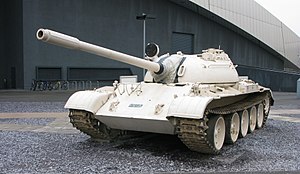T-54
| T-54/55 | |
|---|---|

A T-55 tank.
|
|
| Type | |
| Place of origin | Soviet Union |
| Service history | |
| In service | 1949–present |
| Production history | |
| Designer | |
| Designed | 1945–1958 |
| Manufacturer | |
| Produced |
|
| Number built | 86,000–100,000+ est. |
| Variants | See Operators and variants section below |
| Specifications (T-55) | |
| Weight | 36 tonnes (39.7 ST) |
| Length | 6.45 m |
| Width | 3.37 m |
| Height | 2.40 m |
| Crew | 4 |
|
|
|
| Armour | hull front 120, after 1949 100 mm at 60° angle, turret front 205 mm (rounded), hull side 80 mm at 0° angle, lower hull side 20 mm at 0° angle, turret side 130 mm (rounded), hull rear 60 mm at 0° angle, turret rear 60 mm (rounded), hull top 33–16 mm, turret top 30 mm, hull floor 20 mm |
|
Main
armament |
D-10T 100 mm rifled gun |
|
Secondary
armament |
7.62 mm SGMT coaxial machine gun, (12.7 mm DShK heavy machine gun) |
| Engine | Model V-55(V-54) V-12 water-cooled. 38.88-l diesel 500 hp (373 kW) up to 800hp (597 kW) (late versions) |
| Power/weight | 14.6 hp (10.4 kW) / tonne |
| Transmission | Mechanical [synchromesh], 5 forward, 1 reverse gears |
| Suspension | Torsion bar |
| Ground clearance | 0.425 m |
| Fuel capacity | 580 l internal, 320 l external (less on early T54), 400 l jettisonable rear drums |
| Speed | 48 km/h (30 mph) |
The T-54 and T-55 tanks are a series of Soviet main battle tanks introduced just as the Second World War ended. The first T-54 prototype appeared in March of 1945 and entered full production in 1947. It became the main tank for armoured units of the Soviet Army, armies of the Warsaw Pact countries, and many others. T-54s and T-55s have been involved in many of the world's armed conflicts since the later part of the 20th century.
The T-54/55 series eventually became the most-produced tank in military history. Estimated production numbers for the series range from 86,000 to 100,000. They were replaced by the T-62, T-64, T-72, T-80 and T-90 tanks in the Soviet and Russian armies, but remain in use by up to 50 other armies worldwide, some having received sophisticated retrofitting.
During the Cold War, Soviet tanks never directly faced their NATO adversaries in combat in Europe. However, the T-54/55's first appearance in the West around the period of the 1950s (then the beginning of the Cold War) spurred the United Kingdom to develop a new tank gun, the Royal Ordnance L7, and the United States to develop the M60 Patton.
The Soviet T-34 medium tank of the 1940s is considered to have the best balance of firepower (F-34 tank gun 76.2 mm gun), protection and mobility for its cost of any tank of its time in the world. Its development never stopped throughout the Second World War and it continued to perform well; however, the designers could not incorporate the latest technologies or major developments as vital tank production could not be interrupted during wartime.
In 1943, the Morozov Design Bureau resurrected the pre-war T-34M development project and created the T-44 tank. Thanks to a space-efficient torsion-bar suspension, a novel transverse engine mount, and the removal of the hull machine-gunner's crew position, the T-44 had cross country performance at least as good as the T-34, but with substantially superior armour and a much more powerful 85 mm gun.
...
Wikipedia
